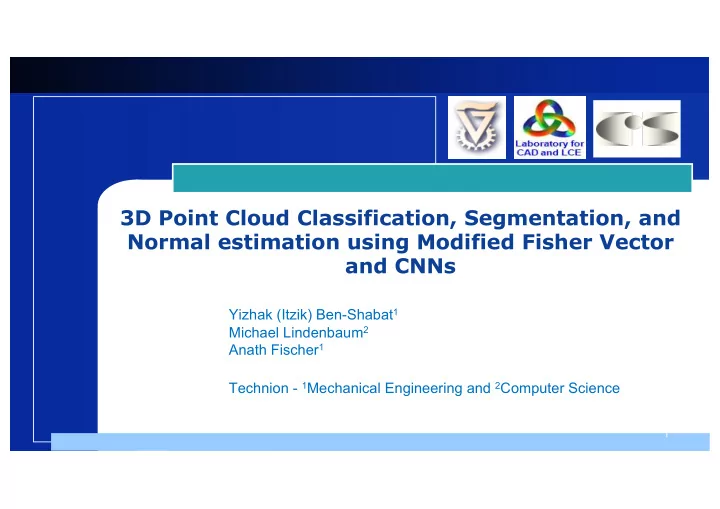

3D Point Cloud Classification, Segmentation, and Normal estimation using Modified Fisher Vector and CNNs Yizhak (Itzik) Ben-Shabat 1 Michael Lindenbaum 2 Anath Fischer 1 Technion - 1 Mechanical Engineering and 2 Computer Science 1
Outline § Point clouds § Point clouds and CNNs – why the connection is challenging? § Fisher Vectors § Representing Point clouds with Fisher vectors § Deep learning with Fisher vectors input § Three applications : • Classification • Semantic segmentation • Scale selection & Normal estimation 2
3D data acquisition 3D Point Cloud Direct 3D sensors are available: § LiDAR § RGBD Camera and provide a set of 3D points = point cloud Point clouds from KITTI dataset and NYU Depth V2 dataset 3
Task 1– Point Cloud Classification Black Mug box Black Table box Black Car box Output Class Input point cloud 4
Task 2– Point Cloud Part Segmentation Point on ? Point on plane tail Point on plane body Point on plane wing 5
Task 3– Point Cloud Normal Estimation Normal estimation algorithm
The preferred tool: Convolutional Neural Networks § In 2D : Deep CNNs revolutionized image analyzed • Convolutional neural nets learn shared weights filters • The input (Image) is specified on a grid structure • Number of pixels in the input image is fixed How can we use them for analyzing 3D point cloud? AlexNet Architecture 7
Challenges § How can we use the power of CNNs with 3D point cloud data? § Representing the input is not trivial: • A point cloud is not a natural input to a CNN § Number of input points is not constant § Data is unstructured (no a signal on a grid) § Linear ordering cannot reflect spatial proximity § No way for unique ordering (permutations) • Other challenges with point clouds § Missing data, noise, rotations 8
Voxelization approach The straightforward approach: transform the point cloud into a voxel grid by rasterizing and use 3D CNNs A choice between Large memory cost and Slow processing time OR No Limited spatial resolution Quantization artifacts A sparsely populated grid which seems un-natural *Image source - AOI-Matlab Voxelizer 9
Multi-View approach § The multi-view approach: project multiple views to 2D and use Image taken from H. Su, S. Maji, E. Kalogerakis, and E. Learned-Miller. Multiviewconvolutional neural networks for 3d shape recognition. In Proceedings of the IEEE 11 International Conference on Computer Vision (CVPR), pages 945–953, 2015.
Direct point cloud approach (PointNet ) Direct approach: • Process each point separately • Pool using an order independent (symmetric) function *Images taken from Qi, Charles R., et al. "Pointnet: Deep learning on point sets for 3d classification and segmentation." , The IEEE Conference on Computer 13 Vision and Pattern Recognition (CVPR), 2017
Previous work Recent reported classification performance *Accuracy is reported on the ModelNet40 Dataset 14
Recommend
More recommend